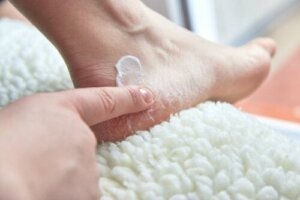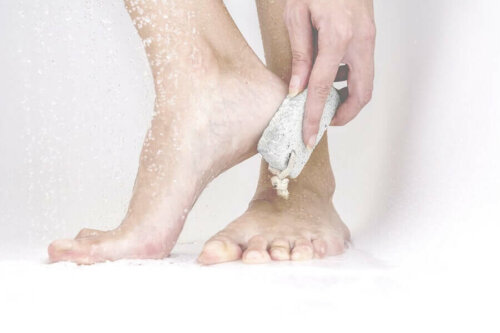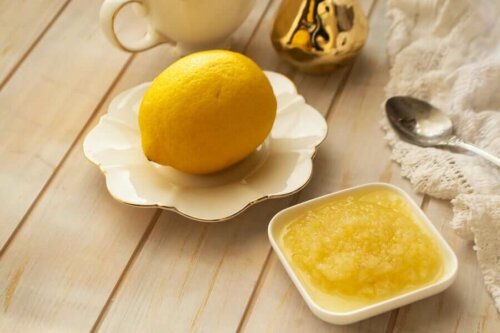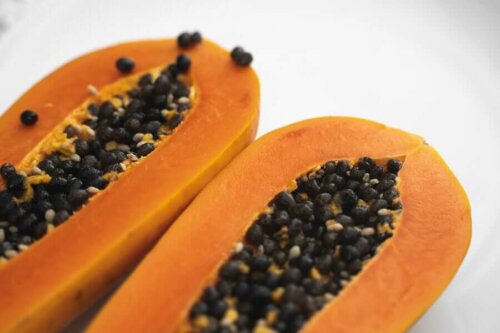Six Ways to Treat Dry And Cracked Heels


Reviewed and approved by the pedagogue in physical education and nutritionist Elisa Morales Lupayante
It takes a great deal of care to get rid of cracked heels. That’s because the skin on your feet is delicate and tends to dry out thanks to certain shoes or the contact of your feet with various surfaces. In fact, according to a report from the National Foot Health Assessment, 20 percent of American adults have experienced cracked skin on their feet.
Although they aren’t usually serious, cracked heels can cause pain, swelling, and other uncomfortable symptoms that can prevent you from performing daily tasks. Furthermore, without proper care, the cracks can bleed or get infected.
The most severe cases should be seen by a doctor, since antibiotics or other medication may be necessary. However, if they’re only mild, there are several home remedies that are easy to make. Below, we’ll give you several options.
Remedies to treat cracked heels
You can initially treat dry and cracked heels at home with some basic treatments. That said, if they don’t improve, you may need advice from a podiatrist as they can cause complications.
According to the Mayo Clinic, the first step is to moisturize them at least twice a day. They advise using thick moisturizers or creams with skin-softening agents, such as urea, salicylic acid, or alpha hydroxy acid, which also help remove dead skin. You can also soak them in warm water and treat them with oil-based creams or petroleum jelly.
There are also a number of traditional remedies that could help alleviate this condition. Although their effects aren’t supported by scientific evidence, anecdotal data suggests they may help treat cracked heels.
1. Pumice stone
The American Academy of Dermatology recommends using a pumice stone to remove excess dead skin that forms calluses on the skin of the feet. Do it gently, after soaking your feet in water for several minutes.

Instructions
- An hour before going to bed, warm some water.
- Pour the water into a container. Put your feet in and soak for 15 or 20 minutes.
- Remove your feet and use the pumice stone to rub your heels, being careful on cracked areas since it could hurt if you rub too vigorously.
- Put your feet back in the water to rinse off the dead skin.
- Gently dry and apply a moisturizing cream.
- Repeat 2 or 3 times a week.
You might like to read: Use Lemon Peels to Heal Your Feet
2. A natural oat exfoliant
Studies haven’t proven that oatmeal heals or removes cracked heels. However, there’s evidence about its benefits for the skin. In fact, a review published by the Indian Journal of Dermatology, Venereology, and Leprology claims that oatmeal has antioxidant and anti-inflammatory properties that help protect the skin.
Therefore oatmeal could help improve the appearance of cracked heels. Furthermore, used regularly, it makes feet smoother and reduces excess dead cells.
Ingredients
- 1/2 cup of rolled oat (100 gms).
- 4 tablespoons of jojoba oil (80 ml).
Instructions
- Mix the oats and jojoba oil together until they form a paste.
- Apply the paste to your feet and gently massage in for a few minutes.
- Leave on for 10 minutes, then rinse with warm water.
- Any leftover paste can be kept in a plastic or glass container to use later.
3. Lemon and glycerine
It’s not advisable to apply lemon juice directly to the skin as it can be irritating if you have sensitive skin. However, in this case, it’s combined with glycerine, rose water, and coarse salt to obtain an exfoliating product that’ll help reduce dry and cracked heels.

Ingredients
- Hot water.
- Coarse salt.
- 1/2 glass of rose water (100 ml).
- 1/4 cup of lemon juice (62 ml).
- 1/2 cup of glycerine (100 ml).
Instructions
- Heat the water and pour it into a large container.
- Add the salt, lemon juice, and glycerine.
- Stir the ingredients a little to help them dissolve and soak your feet in the mixture for 15 minutes.
- Remove your feet and use the pumice stone to get rid of the dry skin.
- In a small bowl, make up the same mixture but with rose water instead of water.
- Mix until a paste is formed and apply to any remaining cracked areas on your heels.
- Put on socks and let the mixture work for 1 to 2 hours.
- Rinse your feet. Repeat the whole process for at least 5 days.
4. Banana and avocado cream
Both the banana and the avocado are used in natural cosmetics for their moisturizing qualities. Avocado, in particular, contains fatty acids, vitamin E, antioxidants, and other nutrients that appear to be helpful against cracked heels.
Ingredients
- 1 or 2 bananas.
- 1/2 medium-sized avocado.
Instructions
- Mix the ingredients together to form a smooth cream.
- Apply to your feet and heels.
- Leave for 30 to 40 minutes then rinse off well.
- Repeat at least 3 times a week.
5. Papaya cream
Papaya is another valuable ingredient in the field of natural cosmetics. Although there isn’t enough evidence to support its effects on the skin, it’s generally considered to be safe. By providing antioxidants and water, it helps recover hydration in the feet.

Ingredients
- Papaya
Instructions
- Mash the papaya to form a purée.
- Apply to affected areas. Remove after 30 to 40 minutes.
- Repeat at least 3 times a week.
Have you heard about? The Benefits of Eating Papaya and its Seeds
6. Overnight oil treatment
Vegetable oils, such as coconut or almond oil, have the ability to help repair the skin barrier, as detailed in research published in the International Journal of Molecular Sciences. Because of this, it’s believed they can contribute to eliminating cracked heels.
Ingredients
- 1/2 cup of coconut oil (100 gms).
- 1/2 cup of almond oil (100 gms).
Instructions
- Mix the two oils together and apply them to your feet.
- Gently massage for about 7 minutes.
- Put socks on and leave them on overnight.
- In the morning, rinse off the treatment.
- Repeat for 6 days or until your heels feel softer and are free from cracks.
Tips to avoid cracked heels
Having cracked heels is quite a common condition. Although they’re usually only mild, if not taken care of, they can lead to more serious problems. Therefore, it’s best to try stop them from occurring in the first place.
Here are some tips to prevent cracked heels:
- Choose shoes that fit well and protect your heels. The most suitable are those with wide and resistant heels that cushion and allow good support.
- Avoid flip-flops and sandals as they can cause the skin to dry out.
- Shoes that are open from behind are also not advisable as they don’t provide ideal support. Also, if they’re too tight, don’t use them, because they facilitate rubbing and the appearance of skin lesions.
- High, stiletto-type heels can cause the heel to expand and be more susceptible to skin damage.
- Maintain good hydration. Don’t forget to include your feet when applying your daily moisturizer. Also, if you have a tendency to suffer from cracked heels, you can use a thicker lotion on your feet and leave it on overnight.
- Inspect your feet often, especially if you have diabetes or a tendency to dry skin.
- Wear good quality socks.
- If necessary, choose custom silicone insoles to balance weight distribution and cushion your heels. You should also change your posture often and avoid sitting for a long time with your legs crossed.
Is it possible to eliminate cracked heels naturally?
In most cases, cracked heels can be removed with basic care and the above remedies. However, if the problem persists or if there’s any risk of infection, it’s advisable to see a doctor or podiatrist.
All cited sources were thoroughly reviewed by our team to ensure their quality, reliability, currency, and validity. The bibliography of this article was considered reliable and of academic or scientific accuracy.
- O’Sullivan, G., Fotinos, C., & St Anna, L. (2012, October). Q/ What treatments relieve painful heel cracks? Journal of Family Practice.
- Sano, H., & Ichioka, S. (2015). Which cleansing care is better, foot bath or shower? Analysis of 236 limb ulcers. International Wound Journal, 12(5), 577–580. https://doi.org/10.1111/iwj.12167
- Pazyar, N., Yaghoobi, R., Kazerouni, A., & Feily, A. (2012, March). Oatmeal in dermatology: A brief review. Indian Journal of Dermatology, Venereology and Leprology. https://doi.org/10.4103/0378-6323.93629
- American Academy of Dermatology Association. (n.d.). HOW TO TREAT CORNS AND CALLUSES.
Retrieved on May 26, 2020 from https://www.aad.org/public/everyday-care/injured-skin/burns/treat-corns-calluses -
Pazyar N, Yaghoobi R, Kazerouni A, Feily A. Oatmeal in dermatology: a brief review. Indian J Dermatol Venereol Leprol. 2012;78(2):142‐145. doi:10.4103/0378-6323.93629
- Lin TK, Zhong L, Santiago JL. Anti-Inflammatory and Skin Barrier Repair Effects of Topical Application of Some Plant Oils. Int J Mol Sci. 2017;19(1):70. Published 2017 Dec 27. doi:10.3390/ijms19010070
This text is provided for informational purposes only and does not replace consultation with a professional. If in doubt, consult your specialist.








